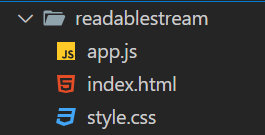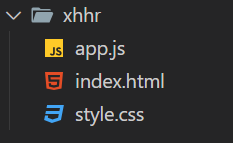|
Streaming responses in JavaScript refers to the process of handling data from a server in chunks as it arrives, rather than waiting for the entire response to be received before processing it. This can be particularly useful for handling large datasets, real-time data, or improving the perceived performance of an application by providing data to the user as soon as it’s available.
There are several approaches to stream response in JavaScript which are as follows:
Using ReadableStream APIThe ReadableStream API provides a way to handle streams of data in a more efficient and flexible manner. It allows you to read the response as it comes in, process it chunk by chunk, and act on it accordingly.
Folder Structure folder structure Example: To demonstrate streaming responses using the Readable Stream API in JavaScript.
HTML
<!DOCTYPE html>
<html lang="en">
<head>
<meta charset="UTF-8">
<meta name="viewport"
content="width=device-width,
initial-scale=1.0">
<title>ReadableStream API Example</title>
<link rel="stylesheet" href="style.css">
</head>
<body>
<div id="content">
<h1>ReadableStream API Example</h1>
<pre id="output"></pre>
</div>
<script src="app.js"></script>
</body>
</html>
body {
font-family: Arial, sans-serif;
margin: 0;
padding: 0;
display: flex;
justify-content: center;
align-items: center;
height: 100vh;
background-color: #f0f0f0;
}
#content {
background: white;
padding: 20px;
box-shadow: 0 0 10px rgba(0, 0, 0, 0.1);
border-radius: 5px;
}
#output {
white-space: pre-wrap;
word-wrap: break-word;
background: #eee;
padding: 10px;
border-radius: 5px;
max-height: 300px;
overflow-y: auto;
}
document.addEventListener("DOMContentLoaded", () => {
const outputElement = document.getElementById('output');
fetch('https://jsonplaceholder.typicode.com/posts')
.then(response => {
const reader = response
.body
.getReader();
const decoder = new TextDecoder();
let receivedLength = 0;
return new ReadableStream({
start(controller) {
function push() {
reader
.read()
.then(({ done, value }) => {
if (done) {
controller.close();
return;
}
receivedLength += value
.length;
const chunk = decoder
.decode(value, { stream: true });
outputElement
.textContent += chunk;
controller
.enqueue(value);
push();
});
}
push();
}
});
})
.then(stream => new Response(stream))
.then(response => response.text())
.then(data => {
console.log("Streaming complete");
})
.catch(error => {
console.error('Streaming error:', error);
});
});
Output:
 ReadableStream API response Using XMLHttpRequest (XHR) StreamingXMLHttpRequest can be used to stream responses by listening to the progress event, which provides updates as data arrives. This method is less modern but still widely supported and useful for certain applications.
Folder structure Folder structure Example: To demonstrate streaming responses in JavaScript using the XMLHttpRequest(XHR) method.
HTML
<!DOCTYPE html>
<html lang="en">
<head>
<meta charset="UTF-8">
<meta name="viewport"
content="width=device-width,
initial-scale=1.0">
<title>XHR Streaming Example</title>
<link rel="stylesheet" href="style.css">
</head>
<body>
<div id="content">
<h1>XHR Streaming Example</h1>
<pre id="output"></pre>
</div>
<script src="app.js"></script>
</body>
</html>
body {
font-family: Arial, sans-serif;
margin: 0;
padding: 0;
display: flex;
justify-content: center;
align-items: center;
height: 100vh;
background-color: #f0f0f0;
}
#content {
background: white;
padding: 20px;
box-shadow: 0 0 10px rgba(0, 0, 0, 0.1);
border-radius: 5px;
}
#output {
white-space: pre-wrap;
word-wrap: break-word;
background: #eee;
padding: 10px;
border-radius: 5px;
max-height: 300px;
overflow-y: auto;
}
document.addEventListener("DOMContentLoaded", () => {
const outputElement = document.getElementById('output');
const xhr = new XMLHttpRequest();
xhr.open('GET', 'https://jsonplaceholder.typicode.com/posts', true);
xhr.onreadystatechange = function () {
if (xhr.readyState === 3) {
const response = xhr.responseText;
outputElement.textContent = response;
}
};
xhr.onload = function () {
if (xhr.status === 200) {
console.log("Streaming complete");
} else {
console.error("Error:", xhr.statusText);
}
};
xhr.onerror = function () {
console.error("Request failed");
};
xhr.send();
});
Output:
 XMLHttpRequest (XHR) Streaming
|




